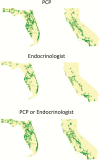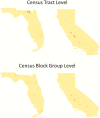The Neighborhood Deprivation Index and Provider Geocoding Identify Critical Catchment Areas for Diabetes Outreach
- PMID: 32676640
- PMCID: PMC7418444
- DOI: 10.1210/clinem/dgaa462
The Neighborhood Deprivation Index and Provider Geocoding Identify Critical Catchment Areas for Diabetes Outreach
Abstract
Purpose: In designing a Project ECHO™ type 1 diabetes (T1D) program in Florida and California, the Neighborhood Deprivation Index (NDI) was used in conjunction with geocoding of primary care providers (PCPs) and endocrinologists in each state to concurrently identify areas with low endocrinology provider density and high health risk/poverty areas. The NDI measures many aspects of poverty proven to be critical indicators of health outcomes.
Methods: The data from the 2013-2017 American Community Survey (ACS) 5-year estimates were used to create NDI maps for California and Florida. In addition, geocoding and 30-minute drive-time buffers were performed using publicly available provider directories for PCPs and endocrinologists in both states by Google Geocoding API and the TravelTime Search Application Programming Interface (API).
Results: Based on these findings, we defined high-need catchment areas as areas with (1) more than a 30-minute drive to the nearest endocrinologist but within a 30-minute drive to the nearest PCP; (2) an NDI in the highest quartile; and (3) a population above the median (5199 for census tracts, and 1394 for census block groups). Out of the 12 181 census tracts and 34 490 census block groups in California and Florida, we identified 57 tracts and 215 block groups meeting these criteria as high-need catchment areas.
Conclusion: Geospatial analysis provides an important initial methodologic step to effectively focus outreach efforts in diabetes program development. The integration of the NDI with geocoded provider directories enables more cost-effective and targeted interventions to reach the most vulnerable populations living with T1D.
Keywords: Neighborhood Deprivation Index; Project ECHO™; geocoding; health disparities; outreach; type 1 diabetes.
© Endocrine Society 2020. All rights reserved. For permissions, please e-mail: journals.permissions@oup.com.
Figures



References
-
- Keenan HT, Foster CM, Bratton SL. Social factors associated with prolonged hospitalization among diabetic children. Pediatrics. 2002;109(1):40-44. - PubMed
Publication types
MeSH terms
Grants and funding
LinkOut - more resources
Full Text Sources
Medical

